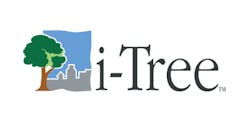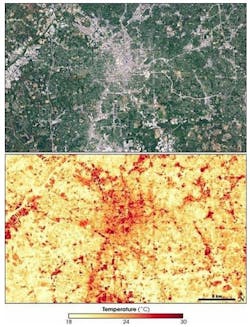Enlisting Trees as Allies in Cooling Urban Heat Islands
In 1913, Joyce Kilmer famously wrote:
"I think that I shall never see... A poem lovely as a tree.”
In Mr. Kilmer’s time, trees were known mainly for their aesthetic value and their role in photosynthesis. Today, we understand that trees, especially in urban areas, can – in addition to producing oxygen, intercepting airborne particulates, and reducing ozone produced by VOCs and NOx – also play a significant role in reducing urban temperatures.
My previous Clark’s Remarks closed with a reference to a recent study authored by Dr. Brian Stone Jr., Professor in the School of City and Regional Planning at Georgia Tech. His research has suggested that tree canopy may be twice as effective in reducing urban heat island (UHI) effects as other strategies.
In addition to the shading effect on reducing temperatures, trees are natural air conditioners. The evaporation from a single tree can produce the cooling effect of 10 room-size, residential air conditioners operating 20 hours a day. There are a number of tools available to officials and consultants to assist in evaluating and planning tree canopy.
While serving on the City of Fort Lauderdale Sustainability Board, I had the opportunity to work with the city’s urban forester, and he introduced us to i-Tree, a “state-of-the-art, peer-reviewed” software suite from the U.S. Forest Service. One of its options, i-Tree Canopy, is used to estimate land cover and tree canopy using random point sampling on aerial imagery. With this tool, users can examine the tree canopy in their own or other communities.
Although the word “climate” was not included in the recently-enacted Inflation Reduction Act (IRA), and not all of the bill directly funds climate-related issues, it does provide investments in healthier forests and tree canopy. The U.S. Forest Service’s Urban and Community Forestry Program will receive $1.5 billion for competitive grants to urban areas for tree planting and related activities.
Trees outside of urban areas will also benefit from IRA funding: National Forest System lands will receive $350 million for vegetation management, environmental reviews, and inventory of old-growth forests, and forest landowners will benefit from $50 million in U.S. Forest Service competitive grants to the states intended to implement practices that increase carbon removal on their lands. Note, too, that many localities have tree give aways, where residents are given trees to take home and plant.
Once again, as with so many issues where the lines between science and politics blur, at the end of the day... it’s really about seeing the forest for the trees.
A regular contributor to HPAC Engineering and a member of its editorial advisory board, the author is a principal at Sustainable Performance Solutions LLC, a south Florida-based engineering firm focusing on energy and sustainability. He can be reached at [email protected].
About the Author
Larry Clark
A member of HPAC Engineering’s Editorial Advisory Board, Lawrence (Larry) Clark, QCxP, GGP, LEED AP+, is principal of Sustainable Performance Solutions LLC, a South Florida-based engineering firm focused on energy and sustainability consulting. He has more than two dozen published articles on HVAC- and energy-related topics to his credit and frequently lectures on green-building best practices, central-energy-plant optimization, and demand-controlled ventilation.

